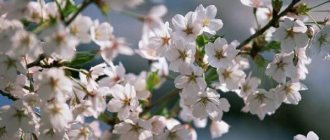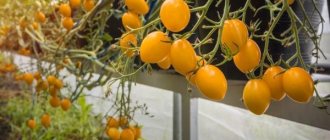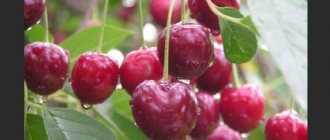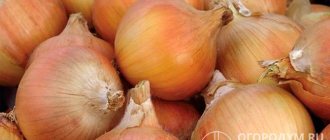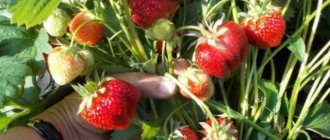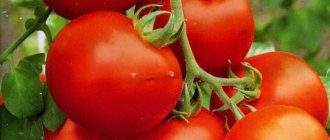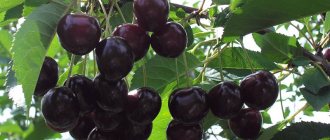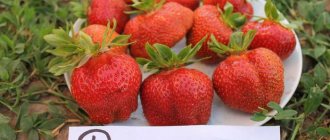The best varieties of large-fruited cherries
Among the many varieties of this variety, several of the most popular can be identified:
- Toy. The tree reaches a height of up to 7 meters and has a spreading spherical crown. The bark on the trunk and skeletal branches is gray with traces of peeling. The berries are large, purple in color, covered with thin skin. The taste is sweet and sour, the bone comes off easily. The tree begins to bear fruit from the third year of planting. One cherry can produce up to 50 kg of berries. The tree itself is frost-resistant, but the buds and flowers can freeze. It is rarely affected by fungi.
- Sister - obtained from crossing cherries and sweet cherries. The fruits are heart-shaped, weigh about 8 g and do not crack. The trees grow tall, up to 6 meters. The first berries appear five years after planting. The variety can withstand frost down to -30°C. The berries withstand transportation well and can be stored at low temperatures for more than a month. The ripening period is the end of June.
- Nochka is another popular variety that is resistant to disease and frost. The dark red, sweet berries are harvested at the end of June. It has a delicate taste, practically no sourness, as it was bred as a result of crossing with cherries. One tree can produce up to 70 kg of large berries, weighing about 7 g.
- Erdi Botermo is a self-fertile variety of Hungarian selection. The berries are scarlet in color with a thick skin and a mild taste. The seeds are easily separated from the pulp. One berry weighs up to 5.5 g. The tree is medium-sized with a spreading crown, bears fruit from the 3rd year. Resistant to clasterosporiosis.
- Bogatyrka - despite its name, it looks very miniature. It grows as a bush up to 2 meters high. The fruits are slightly oval in shape, weighing up to 4.5 g, dark burgundy on the outside, and creamy inside. It tolerates frost well and does not suffer from coccomycosis.
- Miracle cherry - externally the berries and the tree itself look like a cherry. The fruits are 1.5 times larger than cherries - one berry weighs up to 9 g and has an excellent taste. Resistant to drought, frost and disease.
- Black large - received its name for its very dark, almost black berries. It has good yield and frost resistance. The berries weigh up to 6 g each with a sweet and sour taste. Ripens in early July.
Tree care
In the first year of planting, cherry seedlings require weekly watering. If the season is rainy, the frequency of irrigation can be reduced. Starting from the second year, watering is no longer a mandatory procedure, since “Izobilnaya” is a drought-resistant variety.
But in dry years, additional moisture will significantly increase the quality and quantity of the crop. The procedure is carried out in accordance with the life cycle of the cherry, namely during periods when the need for moisture is especially increased:
- immediately after the tree has finished blooming;
- during the period of ovary formation;
- after collecting the main part of the harvest;
- in autumn, after the leaves have dropped.
The watering rate per tree changes with the age of the plant:
- for a one-year-old seedling – 1-2 buckets;
- for young cherries – 2-3 buckets;
- for mature fruit-bearing trees – 5-6 buckets.
Feeding
If the “Izobilnaya” cherry grows on fertile, chernozem soil, then fertilizers should be applied only from the fourth year of planting. Until this time, the fruit tree will have enough natural nutrients and substances added to the soil during planting.
In poor and depleted areas, fertilizing is applied from the second year after transplanting to a permanent place. Approximate fertilizer application scheme recommended by experts:
- as soon as the snow has melted, nitrogen fertilizers are applied to the wet soil;
- at the end of May, repeat fertilizing with nitrogen-containing compounds;
- in the summer, several feedings are carried out with herbal infusions;
- after the ovaries fall off, the tree crown is sprayed with a solution of iron sulfate;
- In September, potassium and phosphorus fertilizers are applied.
Application rates depend on the composition of the soil and the age of the trees.
Advice! To prepare a herbal cocktail for fertilizing cherries, you need to fill any sized container ½ full with young nettle tops and dandelions (roots and leaves), and fill it with water. The container is placed in a sunny place and protected from precipitation. To speed up the fermentation process, add a little yeast or a crust of rye bread to the infusion. After a week, the natural fertilizer will be ready for use.
Cherry pruning
Trees of this variety are pruned very carefully and moderately. Drastic pruning will cause severe stress to the cherry tree and can destroy it.
For the first six years, experts recommend limiting yourself to sanitary pruning only. In autumn, after the leaves have fallen, dried, damaged and diseased branches are removed. Every year, all shoots that form on the trunk below the grafting site are removed.
Starting from the seventh year of growth, thinning pruning is carried out every two to three years:
- remove branches that thicken the crown;
- cut out or shorten shoots that interfere with the normal growth of skeletal branches;
- trim the main trunk if it is more than 20 cm higher than the tops of the frame branches.
Gardeners often complain about the appearance of a large number of shoots near the main tree. This phenomenon is a signal that the cherry is not in the best condition. The cause may be the plant being damaged by a disease, too much pruning or other mechanical damage. You need to try to eliminate the cause of the appearance of shoots, and cut off the grown shoots to the very roots, without leaving stumps.
Bush cherries: planting and fertilizing
In order for bush cherries to produce abundant harvests, it is necessary to create the most favorable conditions for its growth and development.
Landing
The most important thing when planting is to choose a well-lit, flat area for the seedlings. So that in the event of a snowy winter or rainy summer, excess moisture cannot cause damage to the roots of the tree, as well as lead to the appearance of pests and pathogens.
The plant prefers soil with neutral acidity, for example, light or medium sandy loam is perfect. Planting of seedlings is carried out in early spring, after the snow has completely melted and dry, warm weather has established.
Fertilizer
The best fertilizer for cherries is humus. It is applied during planting: 4-5 kg into each hole, and then the cycle is repeated several years later at the rate of 40-60 t/ha.
During the vegetative period, namely in the first 2-3 years of life, cherries need nitrogenous nutrition. Most often, ammonium nitrate (20-25 g per 1 m2) is used for feeding. After 3-4 years (in autumn), additional phosphate and potassium fertilizers begin to be applied: superphosphate - 70 g per 1 m2 of area, potassium salt - 30-40 g per m2, you can also sprinkle the area of the cherry orchard with buckwheat ash - 300-400 g per 1 m2.
Watering
Despite the fact that steppe cherry is not a moisture-loving crop, watering should still be carried out 2-3 times per season: during flowering and fruiting. It is most rational to combine it with fertilizer.
Characteristics of the variety
Izobilnaya produces its first harvest 3–4 years after planting. The fruits ripen in the second half of August. Harvesting must be done in stages, usually done in 3-4 times. Every year the harvest volume increases; the tree produces the largest number of berries in the 8th–10th year. Cherry variety Izobilnaya lives long. If you regularly prune a tree, it will live up to 30 years.
The variety tolerates heat well, so it can be planted in different regions. Trees do not require artificial pollination. They are pollinated by other trees or by insects in late spring or early summer because they are a late variety.
Advantages of growing this cherry variety:
- resistance to frost;
- good harvest;
- the plant tolerates spring frosts because it blooms late.
Disadvantages of growing Izobilnaya cherries:
- small berry sizes;
- the berries do not ripen at the same time;
- it is necessary to harvest several times.
Description of the tree
The Izobilnaya cherry variety reaches a height of 2.5-3 m. The crown has an oval shape and medium density. The leaves of this cherry variety are not wide. The description of the tree states that they are oblong in shape with a smooth surface. The color of the leaves is dark green, and on the underside they are slightly lighter. The shoots form an acute angle directed upward.
Izobilnaya cherry trees grow up to 2.5 m in height, less often - up to 3 m. They have a dense oval-shaped crown. The buds on the shoots bend to the side, their length is up to 3 mm. They point upward, and their base is wedge-shaped. Each bud is serrated and the leaves are concave.
The length of the petioles reaches 9 mm, and the thickness is 1 mm. The inflorescences consist of 5–7 flowers, the corolla width is about 19 mm. The petals are arranged freely and are white. The cups of the petals are goblet-shaped, the sepals have slight serrations.
Description of the fruit
If you provide the tree with the right growing conditions, then in one season a plant that is at least 8 years old will produce about 10 kg of fruit. The harvested crop is well stored, so it can be easily transported.
The fruits of the Izobilnaya cherry weigh 2–3 g (with a length of 15 mm and a width of 16 mm). The color of the fruit and pulp is dark red. The peduncle is 27 mm long and 0.78 mm thick. The seed is round in shape and is easy to separate from the berry. Its weight is about 7% of the weight of the berry.
Izobilnaya berries contain up to 13% dry soluble substances, 7% sugar, 1.7% acids, 14 mg/100 g of ascorbic acid, as well as vitamin P (340 mg/100 g). The berries are juicy and have a sweet and sour taste. Once torn off, the stalks do not release juice, so they are convenient to transport.
In order for a tree to bear fruit well, it is necessary to give it proper care. If you need to delay the flowering of a tree for a couple of weeks, you can cover the ground around the trunk with a thick layer of hay or sawdust. With this help, the root will not receive enough substances necessary for the vegetative system.
If the tree has begun to bloom, but cold weather is expected, smoking will help preserve the crop. To do this, lay out straw or manure, which is set on fire. You need to set it on fire in the morning, and then make sure that the fire does not burn, but smokes well.
https://youtube.com/watch?v=zNzTMARaGnQ
The amount of harvest also depends on the choice of place for planting the seedling, fertilizer and moisture. Abundant cherries bear fruit better if planted in loamy or sandy loam soil. The place should be sunny; you cannot plant it next to tall buildings or fences that provide shade.
Top dressing
It is useful to spray the tree with a solution of boric acid (2 g/10 l of water), this increases the amount of harvest.
In spring you need to feed the tree. This is done before the tree begins to bloom. The solution is prepared from:
- 10 liters of water;
- 10 g urea;
- 25 g superphosphate;
- 15 g of potassium chloride.
The plant is also fed with this solution during the flowering period. Feeding is done every 14 days. The solution can also be prepared from 10 liters of mullein, 1 kg of ash and 50 liters of water. Mix everything and leave for 5 days. Use half a bucket of solution per tree
But it is important to immediately water the tree with 2 buckets of water after the solution.
In summer, subcortexing with mineral fertilizer will be useful. Recharges made from succinic acid and potassium humate will also be effective.
https://youtube.com/watch?v=5MpmIac_0gY
Use of berries
This variety produces round fruits weighing 2.5-3 g (reach 15 mm in length and 16 mm in width). They are slightly flattened at the seam side and rounded at the top. The color is dark red, with almost the same red pulp inside the cherry.
The length of the stalk is 28 mm with a thickness of this part of 0.78 mm. Inside there is a round-oval seed, the mass of which is 0.21 g (that is, 7.5% of the total mass of the fruit). In the upper part it is narrowly rounded, and its base is slightly wider than the top. Separability of the stone from the pulp is average. The fruits of the Izobilnaya cherry variety contain dry soluble substances (13.1%), sugars (about 7.9%), acids (1.7%), ascorbic acid (about 14.1 mg/100 g) and vitamin P (341.6 mg per 100 g). Externally, the fruits are rated 4 points. Their flesh tastes juicy, sweet and sour.
When tasting freshly picked fruits, they can be given 4 points. When separated from the stalks, they remain dry, which means they will not release juice so quickly during transportation.
Like the fruits of many other varieties, the Izobilnaya cherry harvest can be eaten fresh, although it is more suitable for creating preservation (juice or jam) or is used in baking. Compote made from these berries also has a good taste, which, by the way, can also be closed for the winter.
It’s worth starting your acquaintance with Izobilnaya with a description of the variety in order to evaluate all its positive and negative qualities:
- Cherry belongs to the shrub type, its height rarely exceeds 2.5 meters.
- The crown of the tree is compact in size, medium dense, oval in shape.
- The leaves are dark green, narrowly oval in shape.
- The flowers are white in color, collected in inflorescences of 4-6 pieces.
- The dark red berries weigh up to 3 grams. The shape is round.
- The stone makes up 7.5% of the total mass of the fruit and is separated medium-sized.
Abundant fruiting is achieved by following the rules for growing and caring for stone fruit. They are no different from agricultural techniques for other cherries. Watering, timely pruning, adding nutrients, protection from diseases and pests - everything that is needed for full growth and development.
According to professional tasters, the fruits of the Izobilnaya variety received 4 points out of 5 possible.
Cherry common 'Muse'
Main species: Common cherry
| Fruit size |
| Fruit shape |
| Fruit color |
| Winter hardiness |
| Decoration of plants and fruits |
| Flower size |
| Brush characteristics |
| Berry/truss separation |
| Nut kernel size |
| Blush (cover color) |
| Fruit pulp color |
| Density and character of the pulp (fruit/bush/yag) |
| Fruit aroma |
| Frost resistance (fruit/bush/yag) |
| Drought resistance (fruit/bush/yag) |
| Beginning of fruiting after planting |
| Ripening period (fruit/bush/yar) |
| Consumer maturity |
| Productivity (fruit/bush/yag) |
| Fruit shedding |
| Remontant |
| Self-pollinating/self-fertile |
| Purpose of fruits (fruit/bush/yag) |
| Taste of fruits (fruit/bush/yag) |
| Soil pH requirements (fruit/bush/yag) |
| Shelter for the winter (fruit/bush/yag) |
| Soil type (fruit/bush/yar) |
| Disease resistance (fruit/bush/yag) |
| Resistance to pests (fruit/bush/yag) |
| Habitus (fruit/bush/yag) |
| Growth form |
| Crown density |
| Thorns, thorns |
| Vitamin content (fruit/bush/yag) |
| Keeping quality of fruits (fruit/bush/yag) |
| Cultivation region by origin (fruit/bush/yar) |
Expand all properties
Description of the plant:
Common cherry 'Muse' is a seedling from free pollination of the Lyubitelskaya variety. Obtained from the All-Russian Research Institute of Fruit Crop Breeding. Accepted for state variety testing in 1982. Authors: A.F. Kolesnikova, G.B. Zhdanova, T.A. Dmitrieva, M.V. Mikheeva.
The variety is recommended for testing in the middle fruit growing zone.
Dimensions and growth form:
Common cherry 'Muse' is represented by medium-sized trees. The crown is raised, back pyramidal, of medium density.
Mixed fruiting.
Flowers and fruits:
The fruits are medium size, 4 g, flat-round in shape. The skin is dark red with a small number of gray inconspicuous subcutaneous dots, medium density, tender. The peduncle is of medium length, easily separated from the branch.
The pulp is red, tender, juicy. The taste is very good, sweet and sour. The stone is medium-sized, oval-shaped, smooth, and easily separated from the pulp.
Precocity, ripening time, yield:
Cherry's precociousness is assessed as average. Table variety, self-sterile. Medium ripening period. Productivity is high.
Winter hardiness:
Winter hardiness is high. The variety is highly drought-resistant.
Disease resistance:
Common cherry 'Muse' is relatively resistant to coccomycosis.
History of selection
The variety was bred at the Sverdlovsk experimental station in the late 80s of the last century. The basis of the variety was the Michurin varieties of open pollination. Breeders Zhukov S.V., Gvozdyukova N.I. and Isakova M.G. managed to obtain a variety that is characterized by increased winter hardiness and compact size.
In 1992, the Izobilnaya variety was included in the State Register of Fruit and Berry Crops of Russia and recommended for cultivation in the Volga-Vyatka and Ural regions.
The “Izobilnaya” cherry was obtained by selecting planting material from open-pollinated Michurin varieties, which were transferred at the age of one year from SPR and VNIIG.
The originator of the variety is the Horticulture Breeding Station in the Sverdlovsk Region (Russia). In the Volga-Vyatka and Ural regions, the variety was included in the State Register in 1992.
Cherry "Crimson": growing features and care
Crimson cherry was obtained in Russia. The variety was registered in the State Register in 1965. It is recommended for cultivation in the Central region. The main value of the variety is the fruits of very high quality
This is not the only advantage of the Scarlet cherry; we will give a full description of the variety and pay attention to possible disadvantages
Description of the Crimson cherry
The ripening period is average, harvesting takes place in the first half of July. Bagryannaya is popular in all regions of Russia; it tolerates frosty winters well and develops well in hot climates. The best cultivation results are observed in the Moscow, Vladimir, Ivanovo, Tula, Ryazan, Bryansk, Kaluga and Smolensk regions.
The variety is early-bearing, the tree produces its first harvests after 3 or 4 years of cultivation. Good performance is achieved only with group plantings; the best pollinators are considered to be varieties such as Griot Moscow, Shubinka and Sklyanka rozovaya, but you can choose other options, the main thing is that they bloom in the same period, at the end of May.
Characteristics of the tree and fruit
The tree grows up to 1.8 meters in height, the crown is round or slightly elongated, dense, but quite compact. The leaves are rich green in color, glossy on the outside, large or medium-sized, of a typical shape with a finely toothed edge and a slightly pointed tip. Fruiting is observed on annual growths and bouquet branches.
Fruits up to 4.5 grams, round, uniform. The skin is shiny, dark red, strong, almost imperceptible when consumed. The pulp is red, medium density, very juicy, tastes sweet with a refreshing sourness. The stone is small and cannot be separated from the pulp.
Yield and use
The fruits are universal in use, good fresh and processed, and when frozen they do not lose their sweetness and retain their aroma. The yield is average; in group plantings, 6–7 kilograms of fruit are harvested from one mature tree (up to 6 tons per hectare). In particularly favorable years, indicators may increase. The harvested crop is stored in the refrigerator for a little more than 10 days; the cherries do not wrinkle or lose juice during transportation.
Advantages and disadvantages
In general, the Crimson cherry has balanced characteristics, it does not have any extraordinary features, let’s highlight the main thing.
- stable yield without periodicity;
- high marketability and taste of fruits;
- endurance;
- comfortable tree habit;
- precociousness;
- keeping quality and transportability.
Among the shortcomings, such qualities as self-sterility and average resistance to fungal diseases (moniliosis and coccomycosis) deserve attention.
Features of cultivation
Bagryannaya cherry is grown in the same way as other varieties of crops; it develops well in sunny areas with drained, light, medium-loamy, non-acidic soil. Planting can be done in spring or early autumn. Intensive watering is carried out for the first 2 or 3 years after planting, then as needed.
Fertilizers applied during planting last for several years; as soon as the tree begins to bear fruit, it is fed 2 or 3 times a season. The first session is carried out in the spring before the buds open, the second during the flowering period, and the last before wintering. Shelter from frost is required only for very young trees; after entering the fruiting stage, the variety acquires good immunity to low temperatures.
Trimming
As the tree grows, it forms a crown on its own; it only needs to be adjusted. In the spring, before the sap begins to flow, all dry, broken, and diseased branches are cut off; in the fall, you can remove all excess shoots, but unless absolutely necessary, it is better not to touch them. All cut areas must be treated with clay, garden pitch or special putty. The variety produces little root shoots.
Disease Prevention
To prevent cherry trees from suffering from fungi, all fallen leaves are removed in the fall, and the soil is dug up in spring and autumn. The first treatment is carried out as soon as the leaves bloom, Bordeaux mixture (3%) is suitable. The second session is carried out after the petals fall and the fruits begin to pour, use Topsin-M or Skor, strictly according to the instructions. The third treatment is needed after harvesting; for this, a 1% solution of Bordeaux mixture is made.
Many ancient varieties of cherries have become lost; they have been pushed out of the market by modern varieties and hybrids. But there are also those on whom time has no effect; they are sought after in nurseries despite their relatively mediocre characteristics. One of these cherries is Crimson; she will never lose her fans.
https://youtube.com/watch?v=v649JF9-tn8
Harvesting and storage
Harvesting occurs around the second half of June. Fresh berries are stored in the refrigerator for about 10 days. For long-term storage, the fruits can be frozen; after defrosting, they will not lose their taste and beneficial properties.
The harvest is used for processing - jams and preserves, compotes, liqueurs and wines are prepared from the berries.
Miracle cherry is a unique plant, a cherry-cherry hybrid with very tasty berries - sweet, but also with a recognizable cherry sourness. Caring for the plant is not difficult. Juicy berries are not only tasty, but also have a number of useful properties - they prevent the growth of cancer cells and have a beneficial effect on the digestive system.
Felt cherry: cultivation and care
Felt cherry does not tolerate shading when grown and cared for, and it is necessary to protect plants from cold winter winds.
It develops a superficial root system located in a layer of 10–30 cm, which does not tolerate excess moisture at all and can rot.
To plant felt cherries, you need an area with light fertile soils, low groundwater, not flooded under any circumstances, and provided with good drainage and melt water runoff. In areas with winter thaws, it is necessary to plant plants in beds and dig grooves to ensure water drainage from the base of the trunk. You should not try to grow it on heavy clay soils and cold peat bogs. When planting, if the soil is viscous or clayey, sand should be added to the planting hole at the same time as fertilizers and humus in a one to one ratio. If possible, expanded clay should be added to the prepared soil mixture. This will prevent the root collar from ripening in the early spring.
What are the pros and cons
Before planting a seedling, the strengths and weaknesses of the variety that each crop has are studied.
The undeniable advantages of Izobilnaya include:
- Late flowering, thanks to which the flowers of the variety do not experience the negative effects of returning spring frosts.
- The variety is self-fertile, which allows you to save space on the site for planting pollinators.
- High frost resistance, which makes it possible to plant Izobilnaya in regions with harsh, long winters.
- Harvest volumes. Despite its compact size, cherries consistently bear fruit and produce a large number of berries.
- Long period of tree life with regular anti-aging pruning (about 30 years).
The disadvantages of stone fruit culture include:
- Small size berries.
- Late fruit ripening.
- Sourish taste of cherries.
Based on these characteristics, we can conclude that Izobilnaya has many more advantages than disadvantages.
Disease resistance and winter hardiness
As for frost resistance, Izobilnaya was originally bred for regions with cold winters. Freezing of tree buds and bark occurs very rarely. However, experienced gardeners recommend covering young seedlings for the winter and mulching the soil with peat and sawdust. An adult tree does not need additional shelter.
But the culture’s resistance to common fungal diseases of stone fruits (coccomycosis and moniliosis) is average. For preventive purposes, they are treated with copper-containing preparations three times a season.
Of the insects, the tree most often suffers from aphids and slimy sawflies, which damage leaves and fruits. Timely treatment with folk remedies makes it possible to prevent a massive pest invasion.
General varietal characteristics
The variety has good resistance to both heat and drought, as well as low winter temperatures. Therefore, today it has spread widely throughout Russia. “Izobilnaya” is included in the national state register of selection achievements for the Volga-Vyatka and Ural regions.
The first ripe berries appear on the cherry tree in the second half of August. The variety is characterized by non-simultaneous ripening of fruits. Therefore, the harvest stretches for 2-3 weeks.
Description of cherry tree
The plant of this cherry variety is a bush about 2.5-3 meters high. With such a height of the cherry tree, the crown has quite modest dimensions, its diameter does not exceed two and a half meters. Round-oval in shape, it has medium density and a moderate number of leaves. Small oval-shaped buds form on light brown thin shoots. The leaf blades are dark green and have a narrow oval shape. The upper surface of the leaves is smooth, almost glossy, while the lower surface is matte and rough.
Large, snow-white flowers are collected in inflorescences of 5-7 pieces. The light green petioles are thin and long. Due to the late ripening of the variety, flowering occurs in early June, when the bulk of the fruit trees have already bloomed. Late flowering is highly valued in regions where spring frosts return more than once and affect early flowering plants.
It should be noted that during flowering, the “Abundant” cherry is stunningly beautiful and takes on the appearance of ornamental plants. This tree will decorate any area.
Features of pollination
The undoubted advantage of the variety is its self-fertility. The tree bears fruit well in single plantings and immediately after flowering forms ovaries without the help of pollinating varieties. This quality is very valuable for owners of small garden plots where it is not possible to plant several varieties of trees at once.
Characteristics of fruits and their use
The berries of “Izobilnaya” are quite modest in size. The weight of one cherry rarely exceeds 3 grams. Round in shape, they are slightly flattened on the seam side. The skin is medium thick and dark red. The bright red flesh is very juicy and characterized by a sweet and sour taste. Sugar content is about 8%, acid content is about 2%. This indicates a good, balanced taste. The stone is small and easily separated from the pulp.
When picked and separated from the stalk, despite their juiciness, the berries do not wrinkle or flow. The fruits of “Izobilnaya” are not prone to cracking. The combination of these qualities allows them to be transported over long distances and grown for sale.
The extended fruiting period allows you to enjoy fresh berries until September. This berry is also excellent in processing. Cherry compotes, preserves and jams are tasty and aromatic.
Interesting! Cherries contain a huge amount of vitamins, minerals and various organic acids. Daily consumption of fresh berries normalizes the functioning of all vital systems of the body.
Productivity
“Izobilnaya” begins to bear fruit 3-4 years after planting. The harvests are immediately noticeable in abundance. From a ten-year-old tree you can collect more than 10 kg of berries. This characterizes the variety as high-yielding, which fully justifies its name. With good care, cherries will bear fruit for thirty years.
Description of the bush
Nobody would call the “Abundant” cherry bushes compact, because they can reach a height of up to three meters, although most often they do not exceed a height of 2.5 m. At the same time, their oval crown is small, with medium density, which concerns both the formation of shoots , and the formation of leaves.
The oval buds on the shoots are slightly deviated to the side and reach a length of 3.1 mm. They are pointed at the top, and narrowly wedge-shaped at the base, with double-crested serrations. The leaves are slightly concave, glossy, with 2-4 glands at the base.
The length of the light green petiole is 9 mm with a thickness of 1 mm. There are 4-7 flowers in the inflorescence, and the diameter of the flat corolla reaches 19 mm. All petals are placed freely and painted white. The stigma of the pistil (its length is about 9.5 mm) is located above the anthers.
The calyx is goblet-shaped, with medium serrated sepals. Fruiting of cherries of this variety occurs on bouquet branches in the annual growth.
Care
The absolutely unpretentious Miracle cherry variety requires special attention only at a young age. It is very easy to care for an adult tree.
Watering
Young trees require good watering while their root system is developing. A month will require 3 waterings of 15 liters each.
Mature trees do not need water as much and tolerate dry periods well. But what the Miracle cherry does not tolerate is excessive watering, which leads to stagnation of water in the soil. Overmoistening causes cracks in the trunk and branches and leads to gum formation.
In order not to resort to frequent watering during dry periods, you should use a simple but effective method - mulching the soil around the tree. A layer of mulch from wilted grass or peat laid after watering will help retain moisture for a long time. This method also enhances microbiological processes in the soil, improves cherry nutrition and inhibits the growth of weeds.
To prevent water from spreading over the surface of the soil, you need to pour it into a watering circle.
Fertilizers
Cherry Miracle is good because it does not require frequent feeding. If all required fertilizers were added to the soil during planting, then there is no need to fertilize at all for the first 4–5 years after planting.
If the Miracle cherry grows on fertile soils, then mature trees are not fertilized. Organic mulch will be enough, which will enrich the soil with nutrients and improve its structure.
On depleted soils in the spring you can feed the duke with organic matter. To do this, 1 bucket of mullein is diluted with 5 buckets of water and up to 1.5 kg of ash is added. The solution is infused for 4 - 6 days and filtered. The rate for applying the infusion is 0.5 buckets per tree. Fertilizing is applied only after watering, into moist soil.
In the fall, you can apply phosphorus fertilizers - 200 g and potash - 80 g. Mineral fertilizers are applied during digging, scattering them along the perimeter of the crown.
If the Miracle cherry grows on poor lands, it needs feeding
Trimming
Cherry Miracle definitely needs shaping and pruning, since without these procedures the plant stretches strongly upward, acquiring a narrow pyramidal shape. In addition, the variety's branches extend from the trunk at an acute angle, which makes them fragile. To control the growth of the tree and give its crown a hemispherical shape, its branches are given a horizontal position. To do this, weights are attached to young shoots.
They begin to form the crown immediately after spring planting. If planting was done in the fall, then formation begins the following spring.
- To form a trunk, all branches at a height of 25 -30 cm from the soil level are cut into a ring.
- To form a crown, you need to select from 3 to 7 branches. They should be well developed and grow not from adjacent buds, but in different directions. The distance between the branches should be from 8 to 15 cm. The central conductor should rise above the side ones by 20 cm.
- Shortening the branches by 1/3 pushes the seedling to strengthen the establishment of the crown, which in turn will have a beneficial effect on the future harvest.
There is no need to delay the formation of Miracle cherries.
In an adult mature tree, young shoots are annually pruned, which greatly thicken the crown. The rest are shortened by 1/3. Before the growing season begins, old, diseased or damaged branches are cut out.
Shelter for the winter
In mature cherry trees of the Miracle variety, frost resistance is higher than that of sweet cherries, but slightly lower than that of cherry trees. In the southern regions, with mild winters, no special shelter is required. Insulation with a thick layer of mulch will completely protect the duke from freezing of the roots.
In cooler regions, it is worth taking care not only of the root system, but also of insulating the trunks, especially for seedlings planted in the fall. To protect them from frost, the trunk is wrapped in covering materials that allow air to pass freely. Special non-woven material (for example, lutrasil), burlap, thick paper, nylon tights, etc. can handle this task.
Also, don't forget about autumn whitewashing. It will not only become a preventive measure against diseases and pests, but will also protect the trunk bark from frost and the bright spring sun.
A thick layer of mulch will protect the root system from freezing
